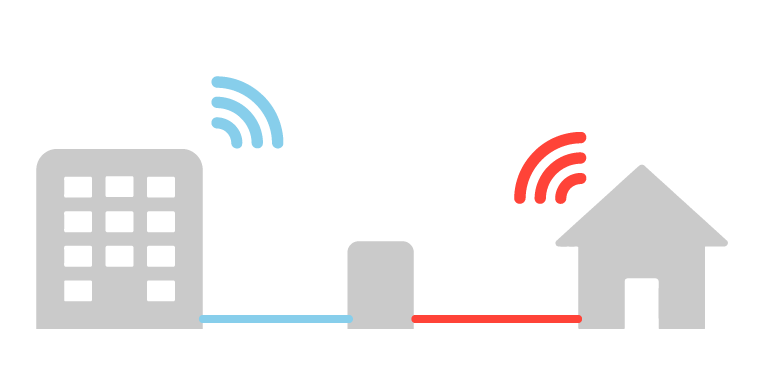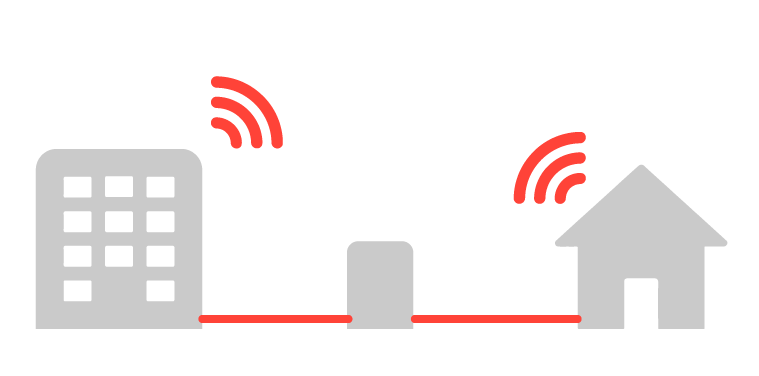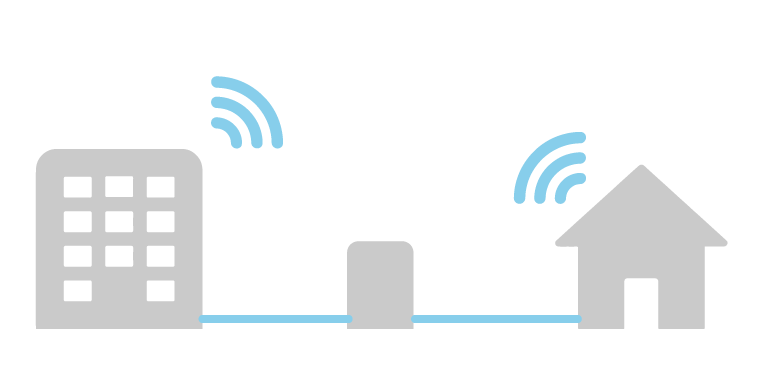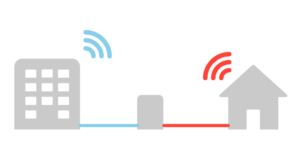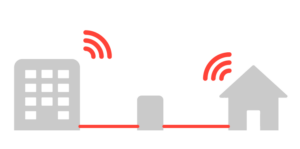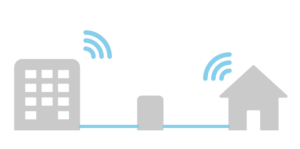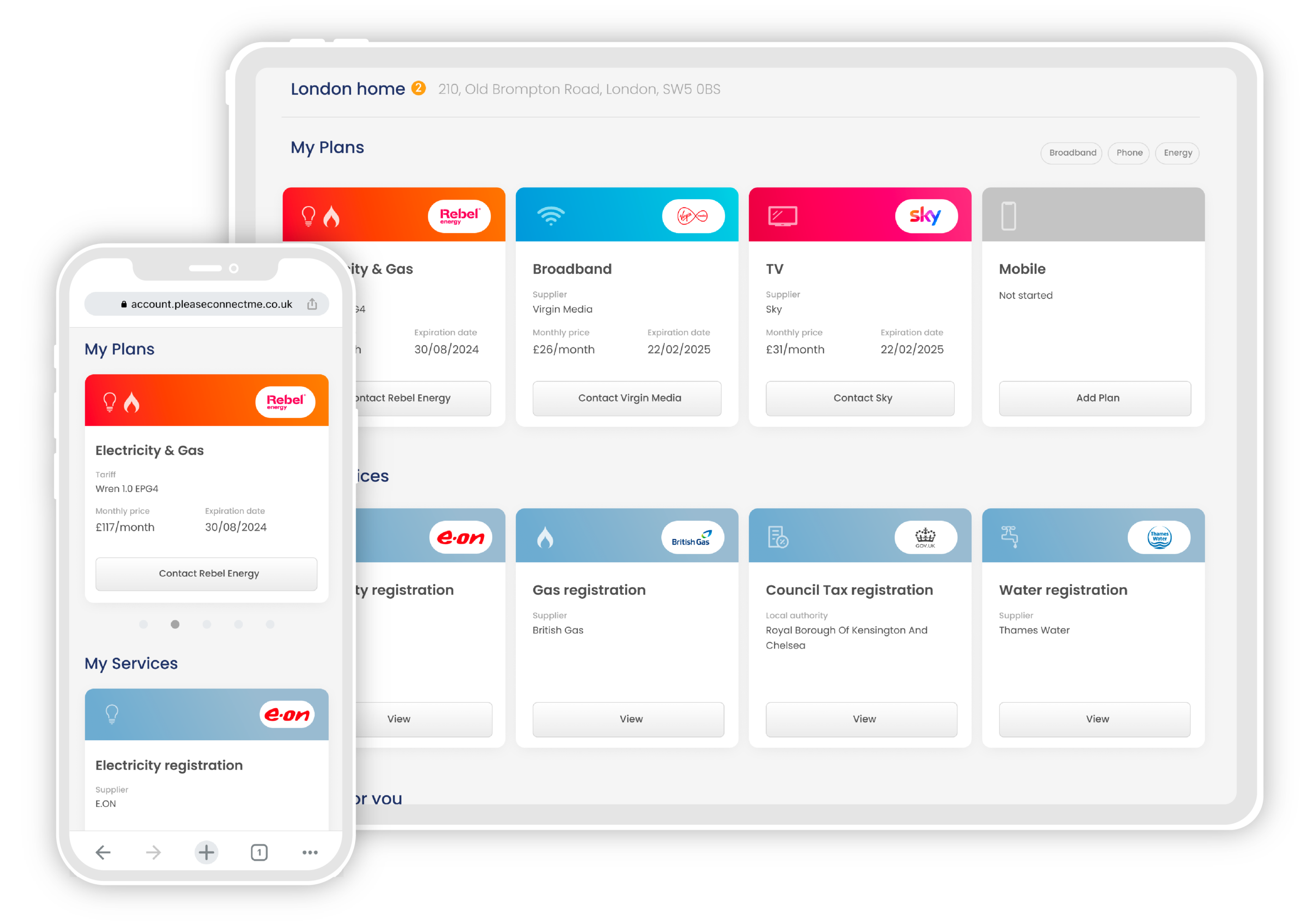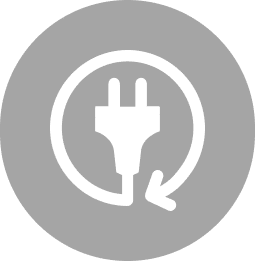In this guide:
Getting internet in the UK
In the UK, home internet access is usually supplied through a private contract with an internet provider. Each provider operates on a particular, physical network, whether it’s their own private installation or a network of shared infrastructure like the Openreach network.
If their network is available at your address then you can place an order with a supplier and have them activate the connection at your address, or install a new access point. You can then connect a router to that access point to create a Wi-Fi network in your home, or use an Ethernet cable for a stable wired connection.
Broadband networks & speeds
Almost everyone in the UK has some form of broadband internet available in their home, but the speed of their connection can range from excruciatingly slow to lightning fast.
The speeds you’re able to reach on your home internet connection depend on a few factors, but the most important by far is the infrastructure available at your home.
What broadband providers are there in the UK?
The largest independent network in the UK is Virgin Media. Virgin use their own infrastructure exclusively, and are available in about 60% of the UK.
A second shared infrastructure network in the UK is the OFNL. Providers on the OFNL include See The Light broadband and Direct Save telecom. OFNL’s coverage is much smaller than either Openreach or Virgin Media.
Other providers operate their own, smaller, independent networks. These include Hyperoptic, Community Fibre, KCOM, G.Network and Gigaclear. Many of these smaller networks will focus on one area or type of building for their installations.
BT (British Telecoms)
Originally founded in 1846, BT (British Telecoms) is the UK’s oldest operating telecoms service. BT was initially a public service, operated by the UK government and funded by taxation, but in 1984 the company was publically sold and became a private brand. They’re the largest broadband supplier in the UK with more than 9 million customers.
BT was responsible for the initial adaptation of the phone network to be able to carry internet signals, but in 2005 anti-monopoly measures required this part of the company to be fenced off. This division is now the independently operated Openreach, who maintain the network used by BT, Sky, TalkTalk and other providers. Despite being separate organisations, BT still has a favourable relationship with Openreach, and are often one of the first suppliers to be able to offer internet services to newly constructed properties.
BT has a strong reputation and a lot of loyal customers having been an internet supplier for as long as there has been internet to supply. For customers in the 2020s, however, BT doesn’t offer a competitively priced or particularly well-reviewed service. While some will always choose the brand they know, if you’re new to the UK we would recommend opting for a more competitive package – which might even indirectly be a BT package (see the section on EE broadband below).
If you’re a sports fan, you may also know BT for their TV channel BT Sport. The channel covers all kinds of live sport, but is considered particularly essential for their exclusive coverage of certain Premier League matches, including many top of the table fixtures. BT Sports isn’t a BT exclusive channel though, and if you’re keen to include in your package it’s available from both Sky and Virgin Media as an add on or included with certain bundles.
Looking for exclusive broadband offers? Sign up to Please Connect me for free today
Sky
Sky is the UK’s biggest subscription TV provider, and that may be what they are best known for, but they are also a broadband powerhouse. In 2021, Sky had more than 6 million broadband customers, making them the UK’s second largest provider.
Many Sky customers favour them because of the option to take a quad-play deal – internet, TV, mobile and home phone from a single provider. These packages usually present huge savings compared to taking the services separately, as well as extra bonuses. For example, if you’re a customer of Sky TV and Sky mobile then you can watch live TV through the Sky Go app on your phone without it being taken from your monthly data allowance.
Sky TV offers the UK’s most comprehensive channel selection. The Signature package – also known as entertainment TV – alone offers more than 300 channels, and the supplier’s popular premium additions like Sky Sports and Movies are the best in class, offering unparalleled selections of live sport and new release and original movies respectively.
Sky has been slower to roll out the highest speeds of internet available to their customers, lagging behind BT in the introduction of 500 mb/s and 900 mb/s options. As of 2022, however, provided the infrastructure is available, you can get the same top-speeds from Sky as you would from any other Openreach provider. For customers who aren’t concerned with speed, Sky also operate a low-cost spin -off service called Now Broadband – read more on Now below.
By Ofcom’s measures, Sky has the best customer service of all major UK broadband suppliers. Between April and June 2022, Ofcom received just 3 complaints per 100,000 customers regarding Sky, the fewest of any tracked supplier and ten times fewer than their worst-performing competitor Shell Energy Broadband.
Looking for exclusive broadband offers? Sign up to Please Connect me for free today
Virgin Media
Virgin Media operates the largest private broadband network in the UK, with their service available in around 60% of properties. Where they are available, Virgin are often the first provider to introduce an Ultrafast (>100 Mbps) fibre service which relies on FTTP technology (see the infrastructure section below for more details). While other suppliers have started to catch up, Virgin Media has kept its reputation as a premium service with top speeds.
Like Sky, Virgin Media also offer TV, home phone and mobile services. The company’s recent merger to form Virgin Media O2 meaning you can take an O2 SIM as part of your larger Virgin Media package. Virgin’s TV services are less comprehensive than Sky’s, with around 100 channels in their entertainment package, but they’re also available to Virgin Media broadband subscribers at a huge discount. Adding TV services to a broadband package currently starts from as little as £3.99 a month. Those looking for the most popular Sky TV options like Sports and Cinema are also able to add these to a TV package from Virgin Media.
While the fact that they aren’t available everywhere is still seen as a drawback, Ofcom has recently forced Virgin media to change their policy around exiting their contracts. In the past, if you moved out of Virgin’s service area during your contract you were expected to pay an exit penalty. Now, if your new address does not have Virgin Media’s service available then you can cancel your contract without incurring any costs.
Looking for exclusive broadband offers? Sign up to Please Connect me for free today
EE
The BT group acquired EE in 2015 and now operates them as a branch of their service. That means EE use the UK’s biggest broadband infrastructure, the Openreach network, and is often the first supplier available at a new property, arriving at the same time as BT.
Why would you opt for EE over their parent company then? Firstly, EE is often cheaper than BT for broadband packages of the same speed, especially if you’re not interested in a package that includes a landline phone. The discounts are even more significant for existing EE mobile customers, who receive both a discount on the monthly cost of a broadband package and a data boost to their existing EE contracts.
EE also outperform BT when it comes to customer complaints. In the same Ofcom study we mentioned in the Sky section, EE came second for the fewest complaints. Ofcom recorded 6 complaints per 100,000 customers in the test period, 25% fewer than BT.
Looking for exclusive broadband offers? Sign up to Please Connect me for free today
Now Broadband
Just as EE operates as another branch of BT, Now Broadband is the budget-friendly arm of Sky’s service. Used by around 600,000 customers, Now has a reputation as one of the very cheapest broadband providers in the UK. You’ll notice the difference in the price you pay for your monthly package, but Now’s service has a few other key differences.
One is in the speeds available – Now keeps their pricing competitive by only offering packages up to an average speed of 63 mb/s, regardless of the maximum speed available on the Openreach infrastructure they use. Now also uses older equipment than many competitors. The Now broadband router is actually a rebranded version of the Sky Q hub, a router that Sky have already phased out of use for customers under the Sky brand.
Customer service is another area where Now shows itself to be a cost-focused supplier. The majority of Now broadband’s support is online, with chatbots and forums recommended as the first port of call before you’ll be able to get through to a customer support agent. This is reflected in Ofcom’s research, which saw Now broadband receive 3 times as many complaints as Sky in their recent survey.
Looking for exclusive broadband offers? Sign up to Please Connect me for free today
Which broadband provider is the best?
Best if you can get them
As a smaller independent broadband provider, Hyperoptic has limited availability across the UK, but if Hyperoptic is available in your building, they’re your best option for a fast, easy to set up and affordable internet connection.
Best for TV & Broadband
Sky is the best provider when it comes to range of TV channels and exclusives. They also save the best deals for bundle packages with broadband, TV and mobile, so they’re the perfect supplier if you want a one stop shop for your telecoms.
Best for Ultrafast Broadband
Which broadband provider has the fastest internet?
This is one of the most common questions we see from people searching for a new broadband package, and the frustrating answer is that it depends on the location and connections at your property.
Generally speaking, the fastest broadband in the UK is supplied by Ultrafast FTTP (Fibre to the Premises) networks.
UK broadband Ultrafast FTTP broadband suppliers
Need internet urgently? Check out our 5G & 4G Connectivity options
How should I choose my broadband provider/ package?
Like with any purchase, everyone has different priorities when it comes to broadband. The first step in the process should be to decide what the minimum broadband speed you need for daily use, as well as what your preferred speed would be and any extra features you would want your package to have. This could be anything from a long contract length to keep your monthly price fixed for as long as possible to a guarantee of internet in every room or an inclusive TV package.
Once you know what your package needs to include, you can start researching which suppliers are available at your address.
Compare their packages at the speeds you’re looking for and decide if you want to opt for the cheapest supplier available, a package with additional features, the supplier with the best reviews or some combination of the above.
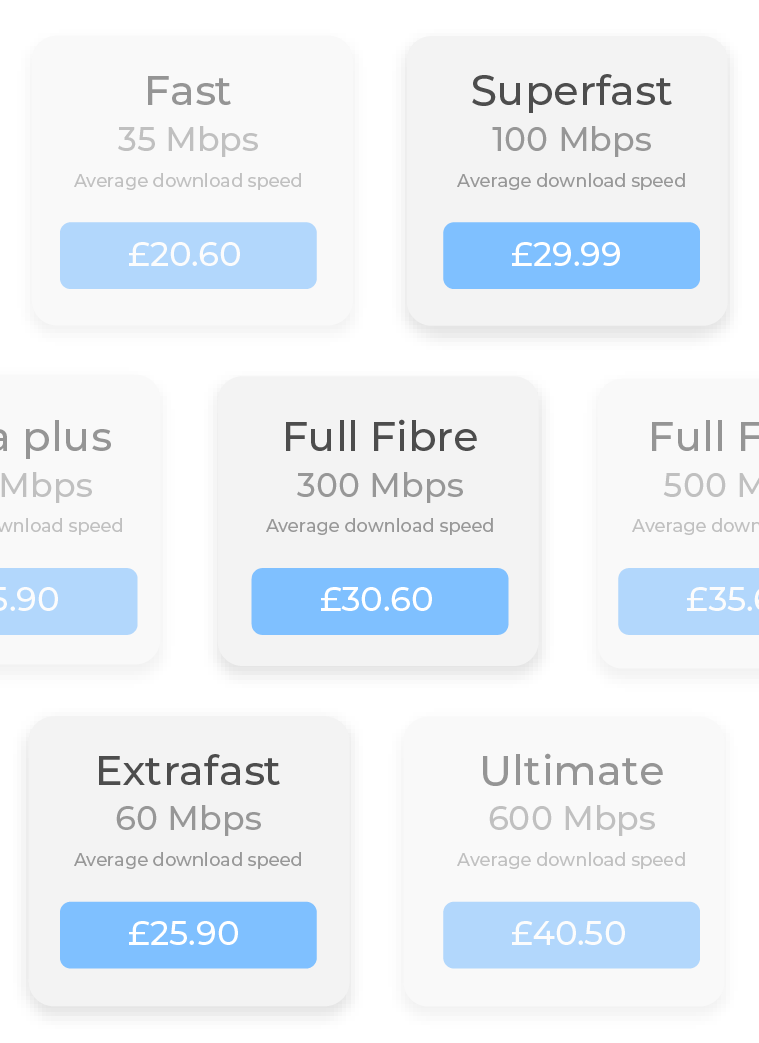
How do I find the best provider available at my address?
The fastest supplier at your address may be different from what’s available to your friends, and even neighbours, so our advice would be to investigate all of the options available to you before committing to a new contract. You can get a general idea of the suppliers available using your postcode on a comparison site, but for many providers the speeds and packages available vary from property to property and not just postcode to postcode.
To get accurate information about of all the packages available, you’ll need to visit each supplier’s website and input your address.
The good news is Please Connect Me make this process easy by running a 24+ point property check on the suppliers available at your property for you. This includes the actual estimated speeds from major suppliers like Sky and Virgin Media, but also independent suppliers you may not have thought to check with like Hyperoptic and G.Network.
Where in the UK has the best broadband?
Moving soon? Let us look up broadband deals for you – Sign up today for free
Where in the UK has the best broadband?
| Area | Properties with Ultrafast broadband |
| Hull | 97.5% |
| Luton | 94.5% |
| Portsmouth | 93.8% |
| Nottingham | 91.8% |
| Belfast | 90.9% |
| Wolverhampton | 90.8% |
| Leicester | 90.8% |
| Middlesbrough | 90.6% |
| Slough | 90.1% |
| Birmingham | 90% |
Source: https://www.broadband.co.uk/blog/2020/10/these-are-the-places-with-the-best-and-worst-broadband-in-the-uk/
What do I need to sign up to broadband?
To place an order for a new broadband contract, there are some details you will always need.
These include:
-
The address you’d like the service installed in
-
An email address
-
A UK phone number
-
Payment method
Depending on the provider this could be a credit or debit card, or they may require the sort code and account number of a UK bank account to set up direct debit payment.
Other than these essentials, you’ll usually need to provide some other personal details and set a security question. You should also have an idea of the broadband speed and package features you would like from the start as this will help you find the best deal.
Need broadband urgently? Check out our 5G & 4G Connectivity options
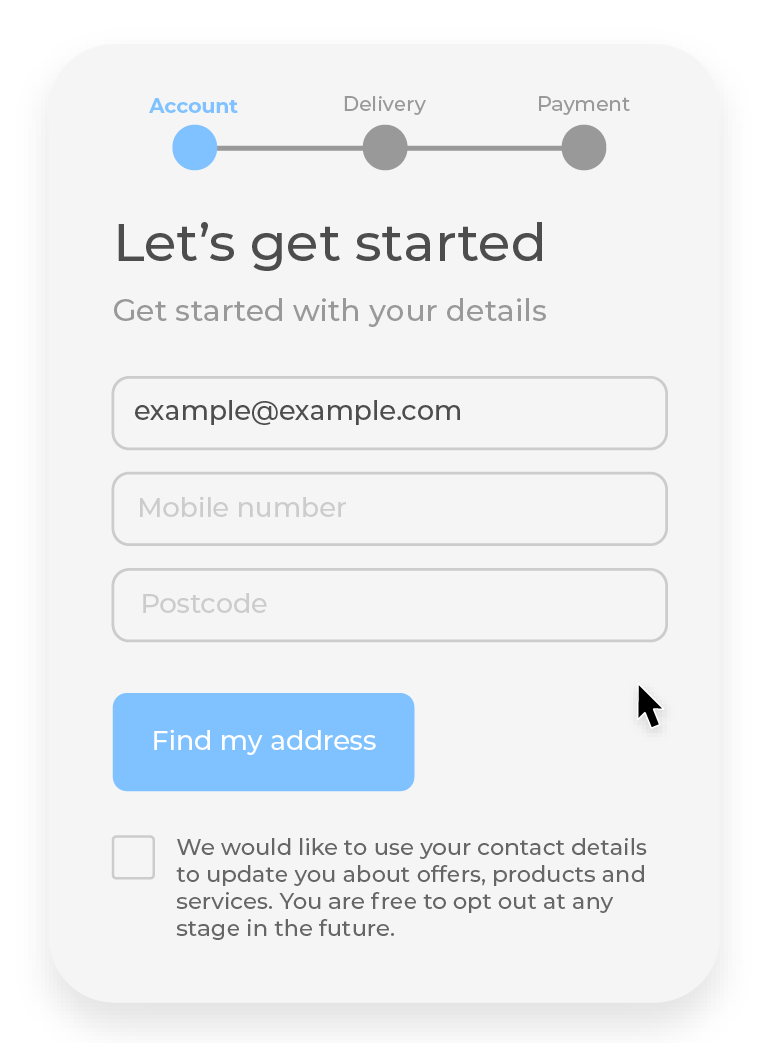
Broadband infrastructures in the UK
FTTC – Superfast Fibre to the Cabinet
The majority of people in the UK get their internet access through Fibre to the Cabinet (FTTC) systems. When internet access was first added to people’s homes, BT and Openreach used the existing copper phone lines to carry the network data, which were limited in terms of speed and capacity. Over time, the cables between the exchanges and the local cabinets were upgraded to fibre optic cable, with the cabling between each cabinet and individual homes being left as the copper cabling.
Fibre optic cable can carry far more information than copper as it transmits data as multiple beams of light across a spectrum. The older copper cables are still used between the cabinet and individual houses, but having fibre to the cabinet increases the maximum available speed from around 11 mbs to 70 Mbps in most cases.
The upgrade from copper to fibre is still being carried out by Openreach, who used to operate as part of BT. Although they are now separate companies, BT still has input on Openreach’s regular operations. The Openreach network is used by BT, Sky, EE, Now, Plus Net, TalkTalk, Vodafone and supermarket internet brands, as well as many other smaller companies.
DSL/ADSL – Old style Copper Cabling and Standard Speed Broadband
The initials stand for (Asymmetric) Digital Subscriber Line. ADSL broadband is delivered through copper phone lines from your local telephone exchange. Estimated speeds are typically around 11mbs, although these can be greatly reduced by the distance from your local telephone exchange to your property.
If you currently only have DSL or ADSL available, but previous occupants or neighbours have had a fibre broadband connection then there may be no slots currently available in the local fibre cabinet. This means that you wouldn’t be able to connect to the local Openreach fibre network – although other networks may be available – until another slot opens up.
You can use BT’s network checker to see the status of the Openreach network at your property. This will show the maximum speeds available, as well as if all the fibre slots in your local cabinet are full.
FTTP – Openreach (Ultrafast fibre)
Fibre to the Premises or Ultrafast fibre is the other end of the of the internet speed spectrum to ADSL, where the entire connection from the property to the exchange is all made up of fibre optic cabling. The typical maximum speed on this connection is between 150 and 900 Mbps, with a few 2GB/s connections appearing. Connections in the 900mbs-1Gbs are also sometimes called ‘Hyperfast’ broadband.
As FTTP is the fastest and most efficient broadband infrastructure available, it is the preferred infrastructure to install in new buildings. There are many different companies currently offering these connections, with availability depending on the property location. Openreach, for example, are installing new FTTP connections where possible in new builds and simultaneously upgrading their existing network.
A property that is connected to Openreach’s FTTP network will have a white box mounted on the wall inside the property called an ONT. ONT’s can be connected to by any Openreach provider, with Ultrafast 900 mbs broadband currently available from BT, EE, Vodafone and, newly, Sky. Some Openreach providers such as Now broadband can connect their routers to an ONT but will still only be able to offer superfast speeds at the property.
If Ultrafast has been introduced to a new area an engineer will need to come to each property to connect them to the Ultrafast network and fit an ONT. New build properties in areas with these services available should have an ONT fitted as standard.
FTTP – Virgin Media
All of Virgin Media’s network is FTTP, with their installation process for an area involving installing network hubs on a street that properties can then be connected to upon request. Virgin Media then drill a small hole in an external wall and fit a connection point inside the property, running cable from the street directly into the home.
If a Virgin Media Property is referred to as ‘Quick Start’ then it has already had this direct fibre line installed. If installation is required then Virgin Media will certainly need to drill into the property, and they often also require that the driveway, path or parking at the front of the house be temporarily dug up.
As with Openreach, Virgin Media offer Ultrafast Broadband up to 1GB/s, although the earliest versions of their ultrafast line were limited to 500 Mbps. Virgin Media deliberately restrict upload speed to around 10 percent of a user’s maximum download speed as a traffic control measure.
FTTP – indepdendent
While Virgin is the largest, there are a number of other independent broadband networks that also only offer FTTP internet. Before you can offer FTTP, your network needs to be installed at street level, and so most providers focus on small areas of specific buildings to make their roll out efficient. If your the first resident at your address to use one of these networks, they’ll need to drill externally and dig a trench at your address to connect you home to their network.
Community Fibre and G.Network both focus on supplying Ultrafast fibre to city centers, focussing on areas with poor or no Openreach support. KCOM are a super-regional network, only offering their service in the greater Hull area. Gigaclear install in rural communities with few fibre options. Hyperoptic, one of our top recommended suppliers where they are available, install in blocks of flats and apartment buildings as they’re being built or renovated, allowing them to offer service to all the residents at once.
FTTP – The OFNL
The ‘OFNL’ or Open Fibre Network is an Openreach alternative shared network which offers ultrafast broadband at up to 360 Mbps for customers across a range of suppliers. There are dozens of companies that operate on this network including ‘See The Light’ and ‘Direct Save Telecom’.
OFNL coverage tend to be in areas where the Openreach network has not been upgraded to fibre. As it is much less well known than either Openreach of Virgin Media’s a network, it is less likely that a property that is being moved into will already have been connected to the network, so a new installation might be necessary. OFNL providers tend to be smaller companies with more basic websites and customer support services.
Broadband FAQs
Should I bundle my broadband?
Generally speaking, if you’re looking to sign up for a TV or mobile contract at the same time as your broadband then you’re best bet is to combine the packages. This will almost always save you money, and can unlock added benefits such as the fact that Sky’s TV box work with their router to create a stronger mesh Wi-Fi network.
The exception to the rule would be if the best supplier available to you for internet does not offer the extra services you’re looking for. In that case, it might be better to take out separate contracts in order to get the internet speeds you need.
What is unlimited broadband?
When broadband was first being rolled out in the UK, many suppliers limited the total amount of data you could download each month, much like current mobile phone internet plans.
As our internet use grew, more and more suppliers switched to unlimited usage across all of their home broadband packages.
Today, the vast majority of internet packages offer unlimited data usage meaning you can browse, stream and download as much as you like.
What is mobile broadband?
Mobile broadband works similarly to traditional broadband, with a router in your home generating a Wi-Fi network and receiving and broadcasting data. Rather than a cable in the ground however, these transmissions are sent wirelessly via satellite. The router accesses this network with a SIM card, just like your mobile phone does.
Using wireless transmissions mean these routers can be used anywhere with mobile signal, without the need to connect to physical network. This makes them portable and much more flexible than traditional broadband, but depending on the network available can limit their capacity.
Do I need to have a home phone with my broadband?
The short answer is no.
If you’re setting up a package today, most providers will have an option for broadband without a phone line. In some cases, however, broadband with a phone line is the cheaper option, in which case we’d recommend choosing the cheaper plan.
If you don’t want to have a home phone, you can leave the line unused and still save.
Do bigger households need faster broadband?
The estimated speeds shown in your broadband contract are not per device, instead, that’s the speed of the whole connection shared across all devices and users. One user with a laptop and a phone on a 60 Mbps connection will be able to receive up to 30 mb/s of data per device.
Five users with a phone and PC each on the same network will only be able to receive up to 5 Mbps per device if they’re all online at once.
What are the peak times for broadband use?
When a provider or a plan refers to ‘peak hours’ for broadband use, they mean the period from around 7 pm to about 9 pm. This is when most people access the internet, and the highest intensity activities like gaming and streaming video are typically done.
Your provider’s advertised speeds need to be available to at least 50% of users at peak times, but you may still experience a drop in speed during this period.
Why are some websites blocked by my internet provider?
Some internet providers have ‘internet safety’ or ‘parental’ controls on websites which you can deactivate through your online account.
If these are disabled and the website you are trying to access is still blocked then the site is likely blocked throughout the UK due to a High Court order or copyright claim. If that is the case you will not be able to access the site through a UK IP address.
What is an IP address?
IP address – short for Internet Protocol address – is an identifier for a device connected to a network. Like a physical address, your IP allows other users to find and share data with your device. Most internet providers assign you a ‘dynamic’ IP address. This means it can change, although it will usually stay the same for months at a time.
If you need a static IP address to connect to secure networks, you’ll need to choose a supplier that can offer them. Currently, Plusnet, Hyperoptic and Zen broadband are among the small group of suppliers who offer static or fixed IP addresses to domestic customers.
How do I check my broadband speed?
There are hundreds of free internet speed checkers online – we’d recommend Ookla’s Speedtest.net. To get the most accurate measurement, make sure only one device is connected to the network, and connect it directly to the router via Ethernet if possible.
Close any apps or programs other than your web browser, with one tab open to the speed test, and don’t touch the mouse or keyboard while the test is running. You’ll be given a download and upload speed in Mbps.





